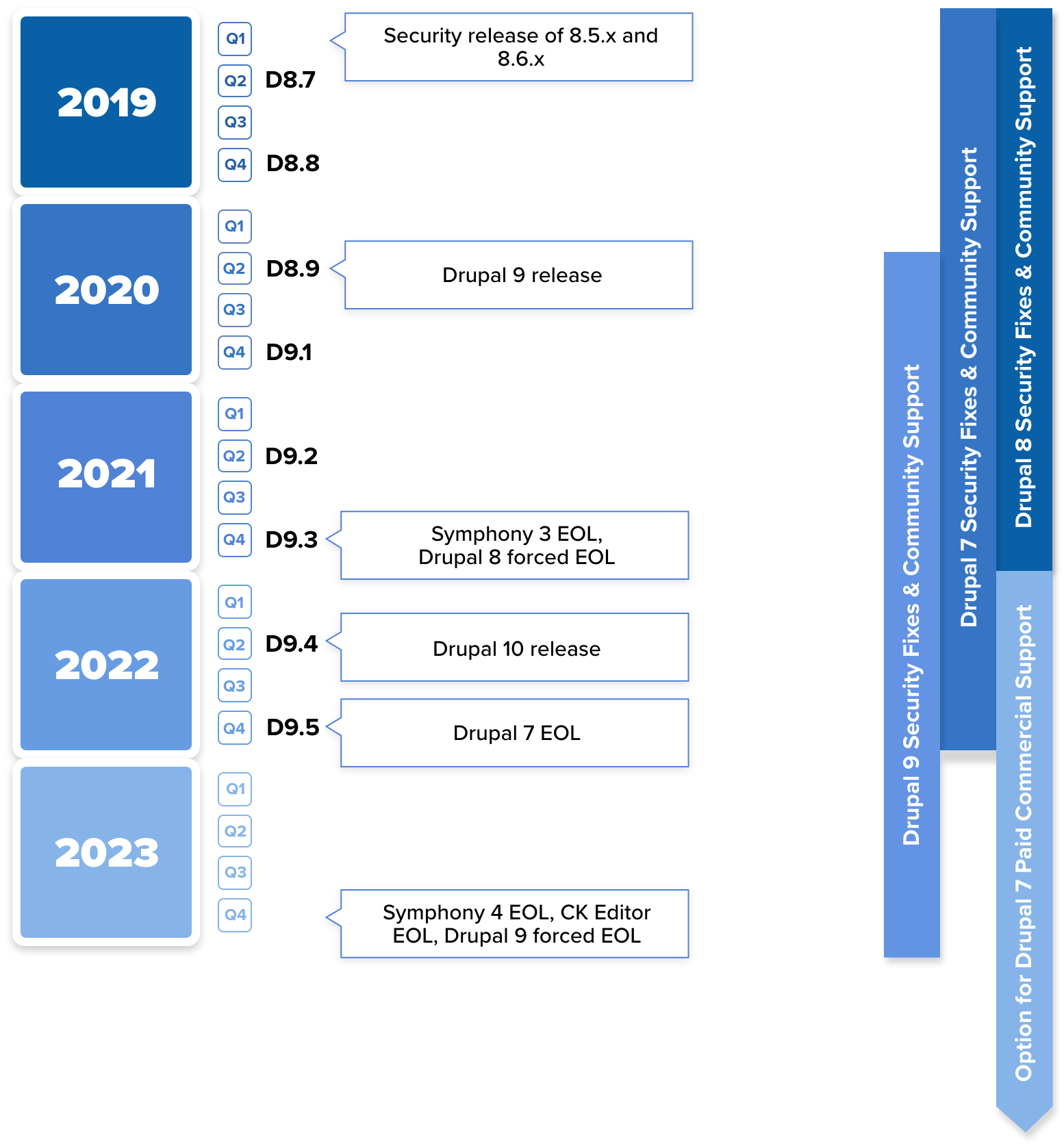When Drupal 8 was first released in 2015, upgrading took more work. The migration and update process was as time-consuming as creating a website from scratch, and adding content was another uphill task. And this problem statement encapsulates the worries that businesses and developers have with the release of Drupal 9 and now with the release of Drupal 10 in December 2022, things can be done swiftly, and updating is no more a tedious hassle.
You will be glad to hear that handling upgrades are simpler now. Accordingly, the effort required to upgrade Drupal 7 to Drupal 10 is comparable to that of Drupal 7 to Drupal 9 as it is going to be Drupal Migration. The Drupal community will have a different experience as a result, and there will be a paradigm shift toward updates being reliable and having a controllable development process.
But why all the fuss if the change makes things simpler? Why do we need to update or migrate anyway? Let’s find out!
Why Migrate/Upgrade to Drupal 10?

Drupal 10 was released by the end of 2022. With a few key upgrades, this newest version of Drupal can provide you with a better user experience. Some of the feature updates are,
- Symfony 4 will be upgraded to Symphony 5 or 6 - Symfony is a PHP web application framework that is used as a foundation for many modern PHP applications, including Drupal. With Drupal 10, the current Symfony 4 framework will be upgraded to either Symfony 5 or 6.
The upgrade to Symfony 5 or 6 brings several benefits to Drupal 10, including improved performance and security. Symfony 5 and 6 are designed to work with the latest version of PHP, which means that Drupal 10 will be able to take advantage of the latest PHP features, including better performance and security enhancements.
Additionally, Symfony 5 and 6 come with new and improved features, such as a new HTTP client, support for PSR-18, and an improved debug toolbar. These features can help developers build more robust and scalable web applications.
Another significant advantage of upgrading to Symfony 5 or 6 is better compatibility with other PHP libraries and frameworks. This will make it easier for developers to integrate Drupal 10 with other applications, and to reuse code across different projects.
- PHP 7 will be upgraded to PHP 8 - PHP is a programming language used to build web applications, including Drupal. In Drupal 10, the current version of PHP, which is PHP 7, will be upgraded to PHP 8.
Upgrading to PHP 8 brings several advantages to Drupal 10, including improved performance, security, and new features. PHP 8 is designed to be faster and more efficient than PHP 7, which means that Drupal 10 will be able to handle more traffic and provide a better user experience.
Additionally, PHP 8 includes several new features, such as the JIT (Just-in-Time) compiler, which can further improve performance. PHP 8 also includes several security enhancements, such as improved support for cryptography and better error reporting, which can help prevent security vulnerabilities.
One of the main advantages of upgrading to PHP 8 is the ability to use new and improved PHP libraries and frameworks. PHP 8 is designed to work with the latest versions of these libraries and frameworks, which can help developers build more robust and scalable web applications.
- Composer 1 will be upgraded to Composer 2 - A composer is a tool used to manage dependencies and packages in PHP applications, including Drupal. In Drupal 10, the current version of Composer, which is Composer 1, will be upgraded to Composer 2.
Upgrading to Composer 2 in Drupal 10 brings several benefits, including improved performance and security. Composer 2 is designed to be faster and more efficient than Composer 1, which means that Drupal 10 will be able to handle dependencies and packages more quickly and with less overhead.
Additionally, Composer 2 includes several new features and enhancements, such as better support for parallel installation and improved handling of conflicts between dependencies. These improvements can help developers manage dependencies and packages more efficiently, and reduce the risk of conflicts and errors.
Another advantage of upgrading to Composer 2 is better compatibility with other PHP libraries and frameworks. Composer 2 is designed to work with the latest versions of these libraries and frameworks, which can help developers build more robust and scalable web applications.
- CKEditor 4 will be upgraded to CKEditor 5 - CKEditor is a widely used rich-text editor that allows users to format and style their content without having to know HTML code. In Drupal 10, the CKEditor version 4 will be upgraded to version 5. CKEditor 5 offers many improvements over its predecessor, including a more modern and intuitive user interface, better accessibility, and improved performance.
One of the main benefits of CKEditor 5 is its modularity. This means that you can easily customize the editor to fit your specific needs by adding or removing features. CKEditor 5 also offers a wider range of plugins than CKEditor 4, which allows for greater flexibility and functionality.
Another key advantage of CKEditor 5 is its improved compatibility with mobile devices. The new editor has been optimized for touchscreens and mobile devices, making it easier for users to create and edit the content on the go.
Drupal 7 to 10 Migration
The EOL for Drupal 7 was set for November 2021 prior to COVID-19. The deadline was extended until November 2022 to give more time for modifications due to the pandemic's effects on businesses. Although the end of life for Drupal 7 is currently scheduled for November 2023, a new statement regarding whether community support will once again be extended is anticipated by July 2023.
Migration Pre-Planning
- Ensure that you have a content architecture.
- Make sure it is cost-effective - If you have enough bulk of content to be spent on migration and is not just easy to recreate.
It is advised that you follow a few steps before migrating to make sure the procedure will go smoothly and produce the intended outcomes.
Configuration and content entities are transferred from the source site to a fresh Drupal site when upgrading from Drupal 7.
It is advised not to consider doing the upgrade on a live site even if it doesn't alter the source site in any way. To guarantee a consistent database state (no writes to the database while the migration is occurring) and to avoid any performance effect on the live site, it is a good idea to utilize a backup of your live site.
This would be the checklist for you if you consider upgrading from Drupal 7 to Drupal 10:
- Find a trustworthy and knowledgeable Drupal partner to assist you with a smooth migration to Drupal from using Drupal 7.
- Upgrade to Drupal 9 as soon as possible if you're still using Drupal 8. (before Drupal 8 EOL)
- Make sure Drupal 9 is upgraded to the most recent (latest available) version.
- Upgrade all of your contributed projects to support Drupal 10 by removing deprecations.
- This will guarantee that it is compatible with all recently published libraries, components, and PHP versions (as their older versions will deprecate in Drupal 10)
- With only a straightforward core upgrade, Drupal 10 will be accessible from here.
Migration Post-Planning
- Verify if the data is properly distributed to the fields
- Verify if the data is completely transferred
Drupal 9 to 10 Upgrade
Because there are fewer minor versions and faster iterations, the transition from Drupal 9 to Drupal 10 will go more smoothly. The procedure for upgrading will be the same as what you did to update to Drupal 9. The contributed modules must work with Drupal 10 and the experts must upgrade the core. Deprecating the modified code is also necessary. Though you can move to Drupal 10 from any version of Drupal 9, It is yet recommended to move to Drupal 10 after upgrading to the newest version of Drupal 9 to decrease the probability of the site breaking.
While upgrading from D9 to D10, the module called ‘rector’ will give you a report after
Analyses the whole code and gives us information about depreciated code or functions in contrib and custom modules which will eventually help you to rectify or make it compatible with the updated current system.
Migration Pre-Planning
- Ensuring you have a backup of the database
- Ensuring you have the latest version of PHP
- Identifying depreciated codes with tools like rector, PHP code sniffer, etc.
- Updating the contrib modules.
The checklist for upgrading your Drupal 9 to Drupal 10 is here,
- Check-in with professionals who may assist you with the whole procedure.
- Get a backup for your site, as it is a crucial step for moving to any version of Drupal from your current one.
- Check if your system meets Drupal 10's system requirements with Drupal Upgrade Install Status and understand the compatibility of your site for the upgrade.
- Administer > Reports > Upgrade Status should be used to determine whether contributed modules require an upgrade.
- Identify the obsolete APIs so you may repair them in your own code as avoiding this step might increase the chances of getting your site broken.
- Use the most recent Drupal 9 release to make sure all deprecated APIs can be found.
- To automatically resolve a variety of problems with your custom code, use Drupal Rector.
- To obtain assistance with any problems, use the Drupal Project Update Bot.
Migration Post-Planning
- Run a regression test (functional and non-functional) to verify every component’s functioning of the system and ensure the code is not broken at any point.
Issues that can come up while migrating and how to help them
1. Migration Failure - While migrating from D7 to D9/10, the data might not be in proper form
During the migration process from Drupal 7 to Drupal 9/10, data may not be in the proper format due to various reasons such as deprecated modules, unsupported code, and customizations. This can cause a migration failure and the website might not function as expected. To help resolve this issue, you can follow these steps:
- Validate the source data: Before starting the migration process, validate the source data and ensure that it is in the proper format.
- Fix deprecated modules and unsupported code: Check for deprecated modules and unsupported code in the Drupal 7 site and replace them with supported modules or code.
- Use a migration tool: Use a migration tool like the Drupal Migrate module to migrate the data from Drupal 7 to Drupal 9/10.
- Test and validate: After the migration, thoroughly test and validate the website to ensure that everything is functioning as expected.
2. Change in architecture and planning in the middle of migration
Sometimes, there might be a change in the website's architecture and planning during the migration process, which can lead to issues. This can happen due to various reasons such as changing requirements, unforeseen challenges, or new opportunities. To help resolve this issue, you can follow these steps:
- Analyze the change: Analyze the change and determine its impact on the migration process.
- Update the migration plan: Update the migration plan to accommodate the change in architecture and planning.
- Communicate with stakeholders: Communicate with stakeholders about the change and its impact on the migration process.
- Re-evaluate the timeline and budget: Re-evaluate the timeline and budget of the migration process to ensure that the change can be accommodated within the project constraints.
- Test and validate: After the migration, thoroughly test and validate the website to ensure that everything is functioning as expected with the updated architecture and planning.
Conclusion
Many major companies base their audience outreach capabilities on the Drupal platform. Despite being open-source, its feature-rich modules can aid in the creation of original digital experiences. Additionally, the Drupal 10 Readiness Initiative makes sure that the CMS receives regular updates that bring newer functionality.
The upgrade to Drupal 10 will introduce a number of enhancements that can improve the user experience for site visitors. To ensure a smooth shift, businesses need to be in touch with migration specialists.
Looking to upgrade your website to the latest version of Drupal? Look no further! Migrate to Drupal 10 with us today and experience the benefits of a modern, fast, and secure platform. Don't wait any longer to improve your online presence - contact us now at [email protected] to get started!
Subscribe
Related Blogs
Trek n Tech Annual Retreat 2025: A 7-Day Workcation of OSL

OSL family came together for the Trek n Tech Annual Retreat 2025, a 7-day workcation set amidst the serene beauty of…
Exploring Drupal's Single Directory Components: A Game-Changer for Developers

Web development thrives on efficiency and organisation, and Drupal, our favourite CMS, is here to amp that up with its…
7 Quick Steps to Create API Documentation Using Postman

If you work with API , you are likely already familiar with Postman, the beloved REST Client trusted by countless…




